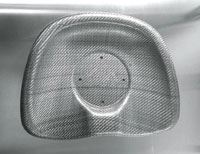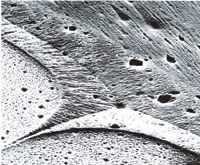Look, No Glass! All-PP Fabric Composites Come to U.S.
Self-reinforcing thermoplastic composites made by consolidating woven fabrics of oriented polypropylene tape are already commercial in Europe.
Self-reinforcing thermoplastic composites made by consolidating woven fabrics of oriented polypropylene tape are already commercial in Europe. Now there are two U.S. sources of these all-PP composites. This month, Milliken & Co., Spartanburg, S.C., is introducing Moldable Fabric Technology (MFT) based on the PURE technology from Lankhorst Indutech bv of the Netherlands. Lankorst patented coextrusion of flat tapes of homopolymer PP sandwiched between PP copolymer skins. The tapes are unidirectionally oriented by cold drawing, which increases strength and stiffness. Milliken weaves the tapes into fabrics and also supplies consolidated sheets made by hot pressing multiple layers of fabric.
Since late 2002, a similar product called Curv, has been produced commercially in Gronau, Germany, by Amoco Fabrics and Fibers Co., a unit of BP Amoco. Last month, that unit was spun off and renamed Propex Fabrics Inc. Propex offers Curv for sale in the U.S., but production and technical service are still located in Germany. Propex supplies consolidated sheet of 0.3 to 3 mm pressed from two to 20 layers of fabric.
Processing and handling these all-PP composites avoids the abrasion and skin-irritation potential of glass fiber. MFT and Curv fabrics and sheets can be molded into finished parts using moderate heat and pressure. In the case of MFT, the copolymer skins of the woven tapes melt to consolidate the fabric at a temperature low enough to prevent annealing the homo polymer tape core, thus preserving its oriented properties. This bi-material structure provides a processing window of 10° to 15° C for consolidating the fabrics into sheets. However, the sheets can be post-formed at temperatures of 140 to 160 C (284 to 320 F).
Curv is based on highly drawn monolayer tapes of homopolymer PP. During sheet consolidation, Curv requires careful process control to melt only a thin outer layer of the tapes while preserving orientation throughout 80% of their thickness. Michel Jansen, manager of new business development in Europe, says the process window is only 1° to 2° C for Propex to consolidate Curv fabrics, but the sheets can be formed by customers over a range of 20° C because the remelted skins of the tapes have a lower softening temperature.
Molding MFT and Curv requires matched tools, or one mold plus a rubber plug or bladder, and moderate pressure of 45 to 300 psi. A hold/slip frame allows the material to slip into or over the mold, instead of flowing as a melt.
Outstanding properties
Milliken says MFT is 30% to 60% lighter, at the same stiffness, than PP, HDPE, ABS, PP/glass-mat composites, steel, and aluminum. MFT reportedly also provides two to 15 times higher impact strength than typical TP composites, even at temperatures down to –40 C. Propex indicates that toughness of Curv increases at low temperatures (see table) where normal PP becomes brittle.
The first European applications for Lankhorst’s PURE material are safety helmets and inner door panels for Mercedes-Benz and Volkswagen panel trucks. The first commercial uses for Curv include Nike protective kneepads, kiteboards, speaker cones, and race-car spoiler lips. Several automotive applications of Curv, including underfloors, are said to be approved for 2007 vehicles. Milliken and Propex say the first applications for MFT and Curv in the U.S. will be truck trailers and water-sports equipment. Potential uses include architectural panels (Curv or MTP skins bonded to cores of EPP foam or PP honeycomb), kayaks, canoes, personal watercraft, snowmobiles, car-top carriers, paddles, ballistic protection, luggage, and piping.
CONSOLIDATED MOLDABLE PP FABRICS (Representative Properties—Can Be Tailored) | ||
| Material | MFT | Curv |
| Tensile Modulus, kpsi | 725-870 | 609-725 |
| Tensile Strength, kpsi | 29.7 | 17.4-26.1 |
| Ultimate Elongation, % | 6 | 16.6 |
| Flexural Modulus, kpsi | 725-870 | 507.5 |
| Flexural Strength, kpsi | 9.4 | 11.6-15.6 |
| HDT, F @ 264 psi | 230 | 216 |
| Notched Izod, ft-lb/in. 68F -40 F | 90 — | 89 140 |
| Gardner Impact, ft-lb 68 F -40 F | 33.3 33.6 | — — |
| CTE, 10-6 in./in.°F | 0.6 | 0.4 |
Read Next
Processor Turns to AI to Help Keep Machines Humming
At captive processor McConkey, a new generation of artificial intelligence models, highlighted by ChatGPT, is helping it wade through the shortage of skilled labor and keep its production lines churning out good parts.
Read MoreWhy (and What) You Need to Dry
Other than polyolefins, almost every other polymer exhibits some level of polarity and therefore can absorb a certain amount of moisture from the atmosphere. Here’s a look at some of these materials, and what needs to be done to dry them.
Read MoreAdvanced Recycling: Beyond Pyrolysis
Consumer-product brand owners increasingly see advanced chemical recycling as a necessary complement to mechanical recycling if they are to meet ambitious goals for a circular economy in the next decade. Dozens of technology providers are developing new technologies to overcome the limitations of existing pyrolysis methods and to commercialize various alternative approaches to chemical recycling of plastics.
Read More


















.png;maxWidth=300;quality=90)





